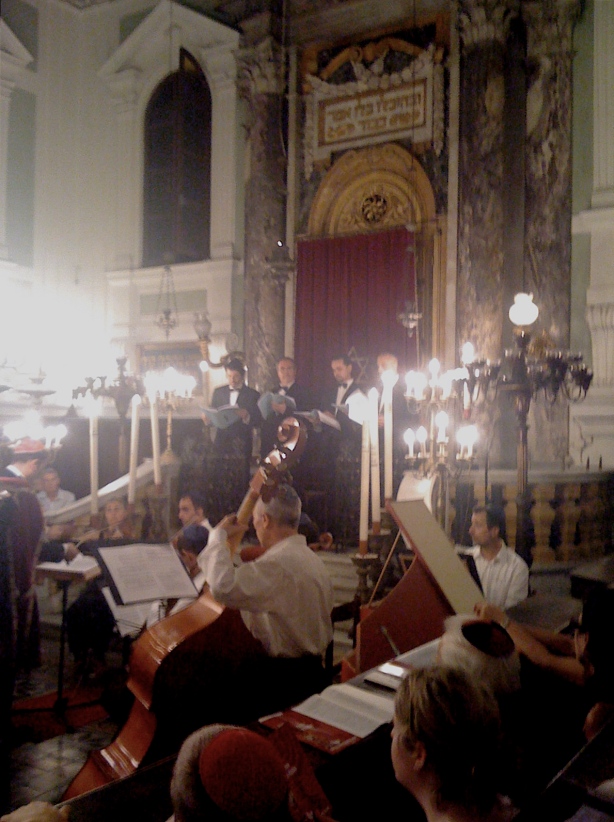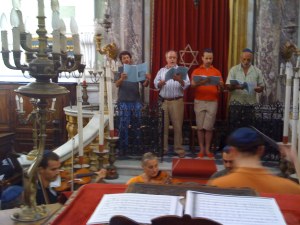
The performance – Il concerto: music by V. Gallichi & F. Drei for the inauguration of the synagogue of Siena (1786).
On the evening of September 6, 2008, motze shabbat shofetim, I was invited to introduce the first modern performance of the music composed in 1786 for the inauguration of the synagogue of Siena in the very same building in which it was first presented. The music, composed by Volunio Gallichi (a Jewish amateur musician) and Francesco Drei (a Catholic Senese composer) to a libretto made of locally written Hebrew poems, was studied, edited and published several decades ago by Israel Adler, and I believed to be already quite familiar with it well before I found myself here:
La sera del 6 settembre del 2008, motze shabbat shofetim, sono stato invitato a introdurre la prima esecuzione moderna delle musiche composte nel 1786 per l’inaugurazione della sinagoga di Siena nello stesso edificio in cui vennero presentate la prima volta. Le musiche, composte da Volunio Gallichi (un ebreo dilettante di musica) e da Francesco Drei (un compositore senese cattolico) su un libretto costituito da poemi ebraici scritti da autori locali, sono state studiate e pubblicate a cura di Israel Adler diversi decenni or sono, e io credevo di conoscerle abbastanza bene prima di ritrovarmi qui:
It was an amazing visit. Seeing the music being rehearsed the day before the performance, then watching the crowd climb into the building (the sanctuary is upstairs) at night, presented me with a whole new understanding of what may have happened there over two centuries ago. A ceremony that served many purposes: aligning the different “souls” of the local Jewish community (which was presumably divided in “Italian” and “Sephardic” Jewish currents, who met at the two pre-existing synagogues – with the Italians interpreting the role of the “conservatives” and the Sephardic Jews starring as the “innovators”) while celebrating a nocturnal Kabbalistic ritual (a progressive form of Judaism, at the time) and involving the local non-Jewish rulers to witness a newly united Jewish community, under the same roof. Keywords that come to mind are, of course, “inter-cultural” and “inter-faith” – the music, the very score, were the products of multiple hands and multiple cultures. People came from far away (even Piedmont) to be present at the performance. The fact that the music was originally presented at night is consistent with other Kabbalistic rituals that Jewish confraternities performed in different Italian cities since the end of the 16th century. Re-reading the text of the ceremony really resonated with me for the first time as a truly innovative attempt to address the structure of the community: it became clear how music was a catalyst in a complex communal process centered around the move to a new synagogue, and thus around abandoning old rituals, old habits, and old social structures. The liturgical IS political, after all.
I have to thank Anna Di Castro and Lamberto Piperno for their vision, their warmth, and (of course) their hospitality. One should really check out these amazing people at their home in Monaciano, which can be found here.
—
E’ stata una visita straordinaria. Vedere le prove il giorno prima del concerto, e poi il pubblico arrampicarsi su per il palazzo (la sinagoga è al primo, ripidissimo, piano) durante la notte, mi ha messo davanti a un modo tutto nuovo di capire che cosa potrebbe essere accaduto lì oltre due secoli or sono. Si trattava di una cerimonia che aveva diversi obiettivi: allineare le diverse “anime” della locale comunità ebraica (che era con tutta probabilità divisa in due correnti, “italiana” e “sefardita”, che si riunivano in due sinagoghe differenti – con gli italiani nel ruolo dei “conservatori” e i sefarditi in quello degli “innovatori”), e al contempo celebrare una cerimonia qabalistica notturna (la qabalah era, allora, una forma di ebraismo progressista) prevedendo anche il coinvolgimento e la presenza delle autorità cattoliche, che venissero a verificare di persona l’esistenza di una comunità ebraica unificata, sotto il medesimo tetto. Le parole chiave che vengono in mente sono, ovviamente, “inter-culturale” e “inter-religioso” – la musica, la partitura stessa, furono il risultato di un lavoro a più mani e culture. Il pubblico venne anche da molto lontano (persino dal Piemonte) per presenziare all’esecuzione. Il fatto che la musica sia stata originariamente presentata durante la notte è in linea con altri rituali qabalistici praticati da confraternite ebraiche in varie città italiane sin dalla fine del XVI secolo. Rileggere il testo della cerimonia ha acquisito per la prima volta un significato tutto nuovo per me: il tentativo, innovatore, di cambiare la struttura della comunità. Mi si è chiarito come la musica sia stata l’elemento catalizzatore all’interno di un complesso processo comunitario incentrato sul trasloco in una nuova sinagoga, e dunque sull’abbandono dei vecchi riti, delle vecchie abitudini, delle vecchie strutture sociali. L’ambito liturgico è, dopotutto, politico.
Voglio ringraziare Anna Di Castro e Lamberto Piperno per la loro creatività, il loro calore, e (ovviamente) per la loro ospitalità. Vale veramente la pena di andare a vedere chi sono queste persone straordinarie, nella loro dimora di Monaciano, che si trova qui.



You must be logged in to post a comment.